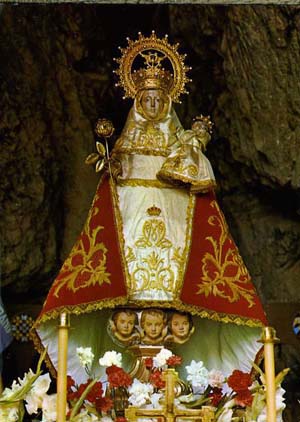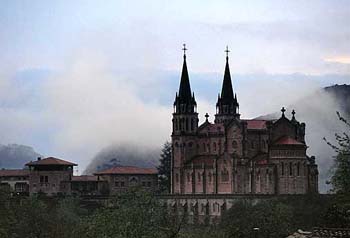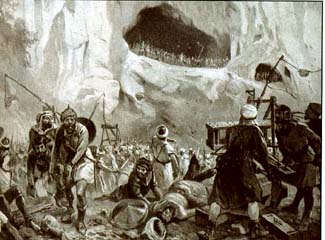Buenos Tardes:
OUR LADY OF COVADONGA, SPAIN
We slept until 8:30 A.M. … had a couple of cups of Café Leche at the hotel restaurant and paid our tab. Headed out for Covadonga to visit Our Lady of Covadonga … a Shrine we have been anxious to visit.
I didn’t tell Susan, but I had planned to by-pass taking the highways and that we would travel almost all the way to Covadonga through the mountains (90 miles up and down the mountain range) because of the previous day’s experience. I knew that once we started up the mountain range on this day, she would forget yesterday’s terror and enjoy the ride. She relaxed almost instantly after Sue took her second “nervous stomach pill” for the day. The ride was just beautiful. (Not too many pictures of the dash board today)
We arrived at the Shrine of Our Lady of Covadonga at 1:00 P.M. and quickly found parking and we set out to explore. The Shrine was busy with other pilgrims and tourists (Pena de Francia was also pretty crowded … I think I forgot to tell you that but it makes us very happy when we see a lot of people visiting these Shrines).
We made our way to the Cave of Our Lady of Covadonga situated in the mountain. Mass was going to begin in 15 minutes (which we knew and had hoped and Prayed we would make it there in time for Mass.)
So we sat down in this truly amazing and peaceful mountain cave and began Praying our Rosaries silently. We had a lot of Intentions we planned to present to Our Lady today … Rosario, you were first. We also decided that this Shrine was a perfect place to Pray for “Our Priests”. Susan and I look at our Pope, our Cardinals, our Bishops and our Priests as our “modern-day warriors” of our Catholic Faith, just as the soldiers who defended this land and won a major battle in 711 A.D. to protect Christianity with the Intercession of Our Blessed Mother after finding Her statue prior to battle (See the story below).
Mass was beautiful. Susan and I both noticed that after the Priest’s Homily, he sat down in his chair next to Our Lady of Covadonga which faced to an area opposite of the cave to the top of another mountain. While looking up at a Cross that could be seen at the top of that mountain, he became visibly emotional, very quiet and he had tears in his eyes as one could tell he was speaking to, Praying to or doing something “very personal to him”. We don’t know what caused it, but it was a “moment” that touched us for him and we decided to add him to our Intention List even though we did not know his name.
After Mass, we sat in front of the Altar and Our Lady of Covadonga and finished Praying our Rosaries, our Daily Prayers and the Prayers for your Intentions. We were Blessed to be able to venerate a large Religious Medal that was attached by a ribbon to the Statue of Our Lady (quite a moment to be able to do that). We visited two Tombs that are kept on the Cave of Our Lady … King Alfonso and King Pelayo. We took more photos and departed the Cave … on to search the remainder of the grounds in Covadonga.
Making our way out of the Cave of Our Lady, Susan started to stop and read the plaques that we on the walls. She began explaining to me that “this Saint had said Mass here in the 1600’s”, that a Pope (specifically, Blessed John Paul II), had celebrated Mass here, etc. I was amazed because, as most of you know, SUSAN CAN’T READ OR SPEAK SPANISH! … IT WAS A “MIRACLE” (ha-ha). After I decided to also look at the plaques (and after making fun of Susan), I realized that I, too, could understand many of the Spanish words too. Now Susan has become the “expert” as she tries to translate everything she sees in Spanish into English … oh boy!
We walked through the Caverns and we lit a candle for all of you and for Rosario who requested that we bring a special written message to Our Lady of Covadonga … which we delivered on her behalf. We were amazed to see that we had spent 2+ hours Praying in the Cave Shrine when it only felt like minutes.
We explored the grounds and the Basilica, making certain not to miss anything. We found a religious store and did our usual … a memento for our religious pilgrimage table at home and a Blessed Mother Medal for Susan’s bracelet.
Feeling confident that we had pretty much seen everything in Covadonga, we departed for our hotel at the base of the Shrine. However, as we passed the Cave on our descent, we heard running water and remembered that we had been told of the “Special Water” in Covadonga so we turned the car around and parked on the lower hill. We both realized that “WE FORGOT THE HOLY WATER”.
It wasn’t easy to find a parking place. So, we kept using the “round about” to keep making circles until we could park. When we arrived at a bridge over the water/spring, I realized that this was not going to be as easy as Lourdes and other places where the water spickets are easily accessible. I immediately saw that there was water flowing from a spring into a cistern directly below the mountain grotto. Empty water bottle in hand. It looked slippery andI didn’t want Susan trying it with her bad foot. I told Susan to be the photographer as I ventured off on my own to walk the bank of the river to get to the spring. Just another “stress point” for Susan as she watched me go off along a very rocky and narrow stone walkway. I was elated and couldn’t wait to get to the area of Our Blessed Mother’s Water. As it looked it was slippery and rough but I went and slow and made it just fine. It was pretty serene and cool at the fountain. I took my time filling the bottle and made my way back.
There are many miracles attributed to the water from the spring that flows under the Shrine in the Cave. There is also a legend that we have been told … anyone who obtains or is given the water from the Spring of Our Lady of Covadonga will be married within one year. If this is true, we can’t wait to get home and share it with many of you … watch out JR (LOL).
Finished with our “mission for the day”, we went on to our hotel. Before checking in, we walked next door since we both realized we were starving. It was 4:00 P.M. and we hadn’t eaten all day.
We had a great meal (only one meal today … have to diet for the meals we know we are in store for in Garabandal for the next two days at Sari’s … can’t wait.
We had plenty of time tonight to get ourselves organized and try to catch up on Trip Reports, e-mails, etc. (You should receive this Trip Report tomorrow at about this time if I am calculating things correctly.)
Tomorrow, we are off to San Sebastian de Garabandal, Spain. We will stop on our way in Santo Toribio with the hopes of having another opportunity to venerate the “True Cross of Our Lord, Jesus Christ”.
Susan and I have been to many, many Shrines in Europe over the years. But, nothing at all is more spiritual for the two of us than visiting Our Lady of Mt. Carmel in San Sebastian de Garabandal … it has felt “like home” to us since our first visit many years ago. I am attaching our story from our very first visit to Garabandal in case you have not read it over the years and if you would like to. Susan and I always say … “this is where it all began for us” … our spiritual pilgrimages and visits to Our Lady.
San Sebastian de Garabandal is the simplest, most humble and peaceful apparition site we have ever visited. Our first visit was 6 years ago and it put the two of us on a “new path”. I think because of Garabandal, we are encouraged to continue to take these “personal pilgrimages”.
We are both so anxious to “make the turn” tomorrow, as we enter the small hamlet town of San Sebastian de Garabandal … a place we call “home”.
Well, it’s time to go to our room now and you know what … SLEEP!
We have received numerous emails from many of you for your Special Intentions as well as your comments (serious and very, very funny responses) and we want you to know that we love them. Rest assured that any of you who have sent us special requests/intentions; you are added to our list as soon as we receive your email. We hope and Pray that your Prayers, through ours, will be answered and, if so, please be sure to let us know so that we can share with others.
We should ask Our Lady for the grace to never doubt a victory that we are sure she wants – even if it seems impossible. We should do everything we can to achieve that goal and trust that she will give the final victory
Always trust in Our Blessed Mother. She is the quickest and easiest path to her Son , Our Lord, Jesus Christ, and to Our Father in Heaven.
God Bless,
Tom & Susan
COVADONGA
In 711 the Muslim Arabs invaded the Iberian Peninsula. The Visigothic King Rodrigo died facing them in the Andalusian field of Guadalete in southern Spain. Taking a position of resistance against the rapid conquest and domination of the infidel, Don Pelayo led a group of valorous knights who had withdrawn to the northern mountains of the Asturias to recoup and fight.
 The Virgin of Covadonga |
Don Pelayo prepared the resistance to meet the large Muslim army at Alzeba Mountain, where the cliffs offered an advantage to the greatly outnumbered Catholics. He placed his men strategically along the cliffs, and while they waited for the enemy to advance, he went to the nearby Cave of Covadonga, where he had placed a statue of Our Lady and asked for her special protection in the coming battle.
The Moors began the attack, sending arrows at the Catholic soldiers behind the stone cliffs. But already, at this first attack, something extraordinary happened: the arrows returned against the Moorish archers who had drawn the bows, killing them. A group of Catholics advanced to fight, while others shot arrows and threw stones and trunks from the Alzeba Mountain down over the enemy troops.
After a short while, Suleiman, the second in command, fell dead, disorder erupted in the army, and Alkamar gave the order to retreat.
At that moment a terrible storm broke out. Thunder roared, lightning lit the dark slopes, and heavy rain caused mudslides that sent boulders and trees tumbling down the mountain and falling over the retreating Arab troops. Struggling in the mud, many Moorish soldiers slipped and fell into the Deva River, where they drowned. The Holy Virgin made the mountain itself fall over the soldiers of Muhammad.
 The Basilica erected in honor of Our Lady of Covadonga |
It was later replaced by a great Basilica that was consecrated in 1901.
Even Arabian historians refer to this battle with astonishment, without hiding the enormous numbers of Muslims who died during it.
Comments of Prof. Plinio:
What is the lesson we can take from these facts?
You know the disproportion between the size of the armies and the means in our battles against the Revolution. Here the selection also describes a great disproportion between the Spanish soldiers and the Muslim troops. From a natural perspective, the Catholics were completely lost. However, they did not give up. They did every possible thing they could to win, even though the victory seemed impossible. I insist on this formula: to do every possible thing to win an impossible victory.
 The Catholics led by Pelayo face the superior Muslim forces |
In this scenario, after they had done what was humanly possible, a series of miracles occurred. They were throwing stones and trunks from the mountains on top of the advancing enemies, as well as shooting arrows against them. Then, Our Lady intervened: she directed the arrows of the Moors to return against themselves. She sent a storm that made the boulders and trees from the mountain fall on top of the enemy hosts. Anyone who knows Spain has an idea of the violence of nature in that mountainous region and can picture a terrible storm with the swelling waters and ground rolling down the mountain cliffs into the valley. Most probably, the Catholics found refuge from the storm either in the Cave of Covadonga or other smaller mountain shelters. With those miraculous actions Our Lady won the battle.
| The Sanctuary in the Cave of Covadonga |
The lesson is that we should have a supernatural perspective to envisage our vocation and our fight. We must do whatever is necessary to win, even when it is impossible. Divine Providence does not ask us to be blind to reality. We must analyze the situation, and even when we see that it is impossible to win this or that battle, we must wage it anyway. We must desire what Divine Providence desires. We must believe in what is humanly unbelievable. We must be convinced that Our Lady is par excellence the Mother of the Impossible. She asks us to do what is impossible – she has the right to ask this of us – and she will come to achieve the victory, after we do everything we can.
The Moors took all of Spain without a serious reaction until Covadonga because they found tepid and mediocre Spanish Catholics, who only had arguments of good sense. They were resigned to do nothing except what was reasonable. So, they were defeated and Spain was conquered.
At the moment when some Catholics believed in the impossible under the protection of Our Lady, the game changed, and the Reconquista began. The Moors were defeated at Covandonga, but also they were potentially defeated in all Spain because of that mentality triggered at Covadonga. Many centuries would pass before the Moors were completely expelled in the 16th century. But the mentality which inspired the Reconquista was the same one that won in Covadonga: To believe in the impossible under the protection of the Virgin.
--


No comments:
Post a Comment
Please no anonymous comments. I require at least some way for people to address each other personally and courteously. Having some name or handle helps.
Note: Only a member of this blog may post a comment.